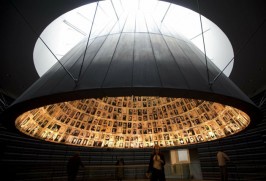Museums used to be a celebration of human achievement. Now they merely peddle misery. Tiffany Jenkins asks why.
The National September 11 Memorial site in New York takes up seven and a half acres of some of the most expensive land in the city.
Two 50ft-deep pools, each containing a fountain, surrounded by the names of the victims of the terrorist attacks, are set in the footprints of the Twin Towers. Pointing towards the centre of the two voids is a new museum that stretches seven stories below ground, built to house the relics of the dead. The museum pavilion will open to the public next year, but there is a preview. In the lobby, next to a family room for the bereaved, visitors come face to face with two of the original tridents – vast steel columns saved from the World Trade Centre. The twisted, wreckage intended, somehow, to embody hope.
Early galleries show morbid mementos donated by relatives, photographs and testimony, after which a slope will take visitors down into a darkened space. This is dominated by the Last Column, also saved from the Twin Towers, a shrine to the lost lives of close to 3,000 people.
The scale and expense of the project – with costs estimated at $700m (£440m), plus $60 for yearly operations – is remarkable, as is the focus. We are used to discreet memorials to war and human sacrifice, but the past 30 years have witnessed a boom in putting tragedy on a pedestal. Memorial museums are proliferating with countless galleries devoted to the display of death and destruction.
In a study of the phenomena, academic Paul Williams found that more memorial museums opened in the past 20 years than in the previous 100. There are 16 Holocaust museums in the US alone (with plans for more), as well as the museum dedicated to the victims of the bombing in Oklahoma City in 1995. Then there are scores of institutions that document slavery in America, and genocide in Armenia, Rwanda and the Balkans.
Others show state repression in Eastern Europe, apartheid in South Africa, political “disappearances” in Argentina, massacres in China and Taiwan, and more. Even within old institutions, such as the Natural History Museum in London, there is a memorial, alongside the dinosaurs and beetles, to the victims of the 2006 tsunami.
Traditionally, museums have celebrated human achievement, culture and science. And while these commemorated events are significant, we should question the flourishing interest in death and disaster, to ask why there is a frenzy of exhibiting the tragic moments of human history.
Of course, these institutions justify their work in the language of education. Alice M Greenwald, director of the National September 11 Memorial & Museum, has claimed: “These exhibits will be an important learning opportunity for people of all ages.” But what do we really learn?
Many of these museums have been architecturally designed to manipulate. Daniel Libeskind’s design for Berlin’s Jewish Museum has passages distorted into slight angles, as if the ensuing destabilisation could hint at the experience of those kept and killed by the Nazis.
The popular phrase is “never again” as if you can prevent bad things from happening by wallowing in the past. The trouble is that the focus on experience, and on the victims – which is the raison d’etre of these kinds of museums, does not allow for complicated reflection. The desperate need for moral certainty does not encourage good history.
Greenwald claims that: “Authentic objects are crucial to understanding the story of 9/11, from the profound loss to the extraordinary heroism.”
So they preserve once meaningless artefacts because the have been “touched” by death. the Smithsonian National Museum of American History 2003 exhibition “September 11: Bearing Witness to History”, displayed the high-heeled shoes removed by a woman when running down the staircase, as well as her briefcase. I honestly believe seeing these would render the event banal.
Sometimes forgetting is good. It is time to dethrone the monuments to barbarity and showcase a little more civilisation.
Tiffany Jenkins is director of arts and society at the Institute of Ideas

